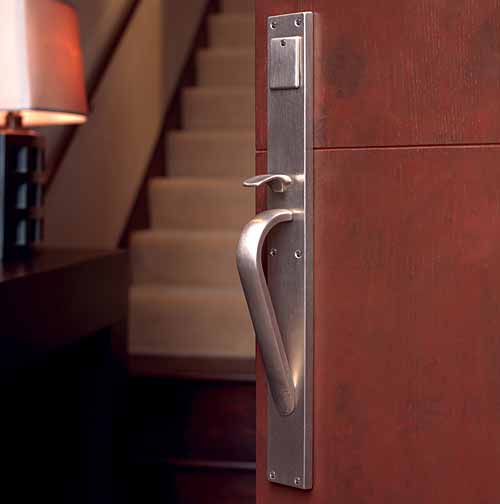Door Hardware Comes of Age
Learning Objectives:
- Discuss hardware trends.
- Identify appropriate design options, functions and mechanisms for hardware applications.
- Define the correct hardware for various door applications.
Credits:
Door hardware is a critical element that provides passage, access, and security but whose operations we take for granted. The aesthetics of hardware design have strong influence on our perceptions of the space we are in or the building we are entering. The architect and designer's selection, application, and specification of door hardware will make a strong contribution to the project's success.
Hardware has evolved from crude, handmade attachments and closure pieces to machine-made, industrialized mechanisms of great precision and design distinctiveness. Most recently, there is a trend in high-end hardware toward distinctive design, which combines highlighting the natural properties of the brass or bronze from which hardware is cast, with its sculpture sense and precision-engineered properties. Hardware, which typically consumes approximately five percent of a building's construction budget, represents an annual construction value of $10 billion to $12 billion.
This article concentrates on high-end hardware for residential, commercial, and hospitality locations. It will familiarize you with the trends, the criteria, and the design decisions that enable the correct selection and specification of hardware for these locations.
|
Trends in Hardware
Hardware as a definer of residential design status has become a deeply entrenched value. Over the past 20 years, people have begun to devote more time and money to transforming their home into showplaces of their design and style. Propelled by this increasing demand, hardware manufacturers began producing door hardware and accessories to meet the needs of architects, designers, and sophisticated homeowners to complement the aesthetics of their design choices. Some manufacturers have responded by combining traditional techniques, such as investment (also known as lost wax casting), and sand casting, with state-of-the-art manufacturing equipment to produce the detail and quality of precisely engineered hardware with a traditional and natural look and feel.
The architectural style choices available today cover a broad spectrum, spanning from modern and post-modern to period, rustic, and traditional. Each style and design vocabulary requires details that work together to provide a harmonious appearance. Unlike the 19th century, when knobs were routine, lever handles have assumed greater prominence. Ease of use, adaptability to meet the Americans with Disabilities Act (ADA) requirements, and a sleek appearance are among the reasons contributing to their popularity.
More natural and organic products, like wood and stone, are being incorporated as major design elements into residential, commercial, and hospitality projects. Hardware, in turn, needs to reflect the natural properties of these materials. This design sympathy with natural products has trended hardware away from manufactured, finished appearances toward living finishes like bronze and patinas, which change naturally over time.
"Designers have embraced newer hybrid styles, such as ‘mountain modern' and ‘coastal contemporary'," notes Patsy Nickum, owner of Rocky Mountain Hardware. These styles combine the clean lines of modern design while integrating the warmth and character of organic materials and colors such as stone, wood, and structural steel. All are materials used in a raw state, were frequently covered with more finished materials, and now they are exposed and aged with time. Designers have begun to reflect the living and changing aspects of materials in their designs.
Increasingly, security hardware and devices are being adapted to many different applications. This high technology trend, combining traditional latch and lock mechanisms with IT systems, represents a design and coordination challenge for both architects and manufacturers.










